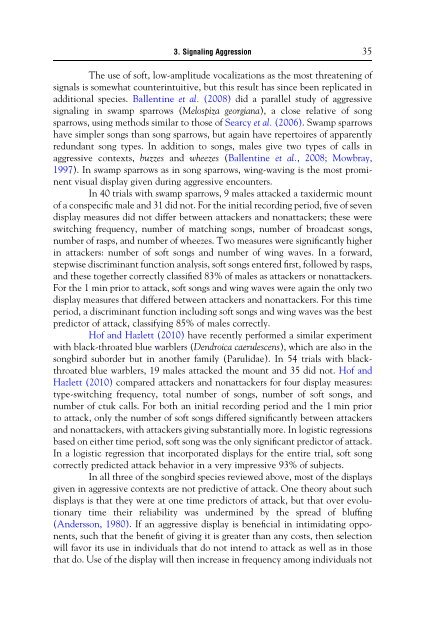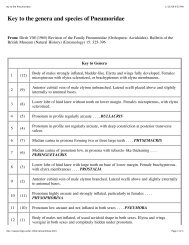full text - Caspar Bgsu - Bowling Green State University
full text - Caspar Bgsu - Bowling Green State University
full text - Caspar Bgsu - Bowling Green State University
Create successful ePaper yourself
Turn your PDF publications into a flip-book with our unique Google optimized e-Paper software.
3. Signaling Aggression 35<br />
The use of soft, low-amplitude vocalizations as the most threatening of<br />
signals is somewhat counterintuitive, but this result has since been replicated in<br />
additional species. Ballentine et al. (2008) did a parallel study of aggressive<br />
signaling in swamp sparrows (Melospiza georgiana), a close relative of song<br />
sparrows, using methods similar to those of Searcy et al. (2006). Swamp sparrows<br />
have simpler songs than song sparrows, but again have repertoires of apparently<br />
redundant song types. In addition to songs, males give two types of calls in<br />
aggressive con<strong>text</strong>s, buzzes and wheezes (Ballentine et al., 2008; Mowbray,<br />
1997). In swamp sparrows as in song sparrows, wing-waving is the most prominent<br />
visual display given during aggressive encounters.<br />
In 40 trials with swamp sparrows, 9 males attacked a taxidermic mount<br />
of a conspecific male and 31 did not. For the initial recording period, five of seven<br />
display measures did not differ between attackers and nonattackers; these were<br />
switching frequency, number of matching songs, number of broadcast songs,<br />
number of rasps, and number of wheezes. Two measures were significantly higher<br />
in attackers: number of soft songs and number of wing waves. In a forward,<br />
stepwise discriminant function analysis, soft songs entered first, followed by rasps,<br />
and these together correctly classified 83% of males as attackers or nonattackers.<br />
For the 1 min prior to attack, soft songs and wing waves were again the only two<br />
display measures that differed between attackers and nonattackers. For this time<br />
period, a discriminant function including soft songs and wing waves was the best<br />
predictor of attack, classifying 85% of males correctly.<br />
Hof and Hazlett (2010) have recently performed a similar experiment<br />
with black-throated blue warblers (Dendroica caerulescens), which are also in the<br />
songbird suborder but in another family (Parulidae). In 54 trials with blackthroated<br />
blue warblers, 19 males attacked the mount and 35 did not. Hof and<br />
Hazlett (2010) compared attackers and nonattackers for four display measures:<br />
type-switching frequency, total number of songs, number of soft songs, and<br />
number of ctuk calls. For both an initial recording period and the 1 min prior<br />
to attack, only the number of soft songs differed significantly between attackers<br />
and nonattackers, with attackers giving substantially more. In logistic regressions<br />
based on either time period, soft song was the only significant predictor of attack.<br />
In a logistic regression that incorporated displays for the entire trial, soft song<br />
correctly predicted attack behavior in a very impressive 93% of subjects.<br />
In all three of the songbird species reviewed above, most of the displays<br />
given in aggressive con<strong>text</strong>s are not predictive of attack. One theory about such<br />
displays is that they were at one time predictors of attack, but that over evolutionary<br />
time their reliability was undermined by the spread of bluffing<br />
(Andersson, 1980). If an aggressive display is beneficial in intimidating opponents,<br />
such that the benefit of giving it is greater than any costs, then selection<br />
will favor its use in individuals that do not intend to attack as well as in those<br />
that do. Use of the display will then increase in frequency among individuals not



